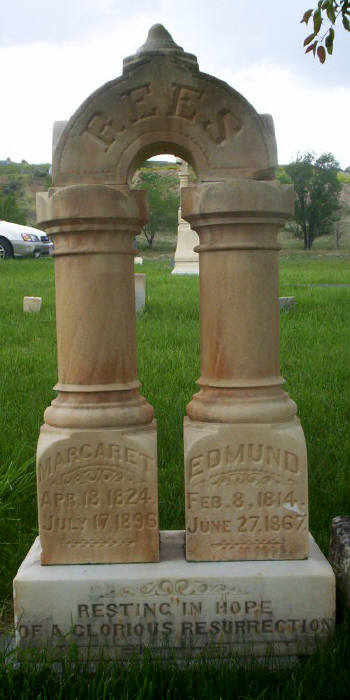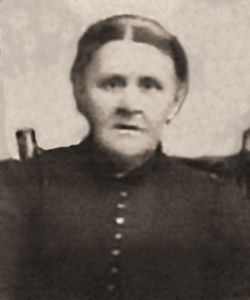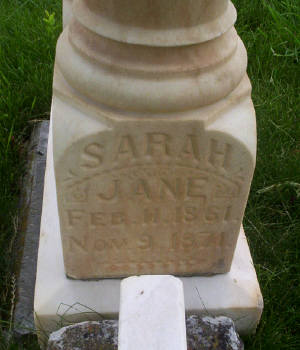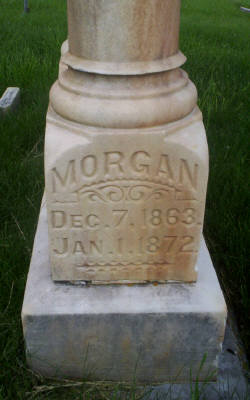
On September 22, 1859, Edmund Rees, wife Margaret, and the five Rees children (ages 12-18 months) arrived in Great Salt Lake City, the twelve-year old capital of the nine-year old Utah Territory. Edmund and Margaret were natives of Monmouthshire in the southeastern corner of Wales. While they’d both joined the Church of Jesus Christ of Latter-day Saints in the early 1850s, they didn’t gather to Zion and emigrate to Utah until Edmund developed asthma after years spent cutting coal in the Monmouthshire mines that fueled the early Industrial Revolution.
The Rees family started their journey with $500, the results of selling their home. $100 got them from Wales to Iowa: they left the old country on April 11, 1859, sailed across the Atlantic on the John Talbot, landed at New Orleans, and sailed up the Mississippi and Missouri Rivers to Council Bluffs, Iowa by steam boat. Another $100 got them two oxen, a covered wagon, a milk cow, and safely across the Plains to Utah.
Edmund was unfamiliar with handling livestock: the first time he put the yoke on the oxen, he put it on upside down.
So Margaret took over.

Family history records that Margaret Rees was “well built, quite stout, weighing about 155 pounds”. It was later reported that:
Mother Rees must have been quite a person. Family traditions remember her hiking to and from Salt Lake a number of times. Once in midwinter she made the trip home carrying a fifty—pound sack of flour to feed her family, who had apparently been made ill by some locally ground wheat. She is also credited with carrying two five gallon cans of water simultaneously, one in her hand and the other on her head.
The town the Rees family settled was Coalville, the current county seat of Summit County, Utah. It’s “Summit” County for a reason: it’s located in the middle of the Wasatch Mountains, itself only a small part of the greater Rocky Mountain chain. Salt Lake City is 4,226 feet above sea level. Coalville is 5,577 feet above sea level. Coalville to Salt Lake City and back is roughly ninety miles down and back up through Parley’s Canyon. Parley’s is relative broad but the stretch between Salt Lake and the modern ski resort of Park City is “relatively twisty and narrow and had to be dynamited to make way for I-80”. The drive is demanding even with Interstate 80. Snowfall in winter is deep. Car accidents with fatalities are frequent in the snow and ice.
Margaret made the trip on foot without snow shoes in mid-winter while carrying 50 pounds of flour.
That was the future. In the summer of 1859 Margaret had the same sturdy Welsh build but was ten years younger. Taking five pre-teens and an ill husband one thousand miles across the Great Plains was well within her power. Making that initial crossing, Margaret even discovered that she could milk the cow in the morning, let the motion of the wagon churn the cream all day, and serve butter to the family at night (unfortunately, after the Rees entry into the Salt Lake Valley, the milk cow wandered off and was never heard from again).
Brother Brigham called for members with coal mining experience to go up Parley’s and work a recently discovered coal strike. Compared to the well-watered Eastern States, trees are scarce in arid Utah. Coal was necessary to keep Salt Lake City warm in the winter. So up Parley’s these brothers and sisters in the Gospel, many of them recent Welsh converts like Edmund and Margaret Rees, went. The Rees family was among the first nineteen families to settle. Margaret was the first white woman to endure that first Coalville winter. It’s very cold in those mountains and its even colder when you live in a dugout.
Even when they were able to build a more permanent dwelling, there was little rest:
Coal mining was hard physical work. Men worked twelve-hour shifts after sometimes walking or riding a horse several miles to and from the mine portal. Men performed manual labor with pick and shovel…The mines closed on Sundays, which were the only break in a long week for the men.”…In addition to the heavy manual labor of mining, hanging over the workers heads was the constant prospect of being laid off, not to mention the hazards of working in a mine.
Margaret’s work load was heavy since Edmund was away earning wages in the mine. But Edmund died on June 27, 1867. Family history records: “This left Margaret with 6 children to raise and feed in this strange land”.
The history of Coalville observes:
Because of so many fatal accidents, Coalville was different from other towns because it had a greater share of widows than the average Utah settlement…The widows and their children struggled along until the sons got old enough to work. Widows wanted to be independent and self sufficient, but there were few ways for women to earn money in that time. Because many widows were reluctant to ask for help unless absolutely necessary, farmers made a practice of leaving certain portions of their fields unharvested so the widows could gather their own wheat, without actually having to ask. Businessmen helped out by offering employment to sons of widows when they had jobs the boys could fill.
Now Margaret not only faced cold but other threats to the survival of herself and her children:
Fifty years after the first settlers arrived, someone asked the old-timers present to write down what they best remembered about the early days. The grasshoppers and the frost stood out most in their memories as being the most difficult to cope with.
The grasshopper was the dread Rocky Mountain locust:
The Rocky Mountain locust (Melanoplus spretus) was the locust species that ranged through almost the entire western half of the United States (and some western portions of Canada) …Sightings often placed their swarms in numbers far larger than any other species of locust, with one famed sighting having been estimated at 198,000 square miles (513,000 km ²) in size (greater than the area of California), weighing 27.5 million tons, and consisting of some 12.5 trillion insects – the greatest concentration of animals ever recorded, according to The Guinness Book of Records.
Rees family history records:
Margaret had ten acres of wheat planted. It was a fine crop and she was proud of it. It meant food for her family that winter. One night Margaret heard a rushing noise, something like an airplane makes overhead today. She wondered what it was and went outside, followed the sound until she located it in her wheat field. It was grasshoppers. At daybreak she went out to the patch again only to find that every green blade of grain was eaten off.
She walked back to the house thinking how she would tell her husband forgetting for the moment that he was dead. The children were still asleep. She sat down on a bench outside the door and broke down and cried. What would they do for the winter’s food? Hearing a noise, she looked up to see an approaching four—mule team driving up. It was remnant of Johnston’s army [probably not since the last of that force withdrew from Utah over ten years before at the beginning of the American Civil War]. They stopped and asked if she had any milk to sell. She did have a cupboard full of milk in pans, heavy thick cream and fresh butter and eggs. The men were bighearted Irishmen. They heard her story and for every pan of milk that she set out they threw her down a sack of provisions and when they left she had enough food for the winter. She had prayed and the Lord did provide.
The Lord provided even more:
The last major swarms of Rocky Mountain locust were between 1873 and 1877, when the locust caused $200 million in crop damage in Colorado,Kansas, Minnesota, Missouri, Nebraska, and other states. The cause of their extinction was probably the plowing and irrigation by settlers that disrupted the natural life cycle of the insects in the very small areas they existed in between swarms. Reports from this era suggest that farmers killed over 100 egg cases per square inch while plowing, harrowing or flooding. More likely the extinction was by a new plant by farmers like Neem tree with poison meliantriol already known for stopping locust spreading…
…the species was apparently extinct, with the last recorded sighting of a live specimen in 1902 in southern Canada. And because no one expected such a ubiquitous creature to become extinct, very few samples were ever collected (though a few preserved remains have been found in Grasshopper Glacier, Montana). Though grasshoppers still cause significant crop damage today, their populations do not even approach the densities of true locusts. Had the Rocky Mountain locust continued to survive, North American agriculture would likely have had to adapt to its presence (North America is the only continent without a major locust species outside of Antarctica)
Margaret endured to the end, seeing six of eight children reach adulthood and prosperity (11 year old Sarah and 7 year old Morgan died within a month of each other in late 1871-early 1872 from diphtheria).


Margaret outlived Edmund by 29 years, living to 72 despite dwelling high in the arid mountains of frontier Utah. She died on July 17, 1896, a few months after Utah became the 45th state on January 4, 1896 and just six years before her old nemesis Melanoplus spretus was last seen on this Earth.
Thanks for sharing.
Those guys were tough in those days in ways most people now can’t even imagine.
And I am interested in the West in “pre-Gold Rush” days, when the only white settlers were (for the most part) Mormons (who came west escaping persecution) and Europeans like John Sutter given Spanish land grants. I’m talking about California, Nevada and Utah….
I would say that you are from some sturdy stock, Mr Rees.
BTW there is an interesting account from Mark Twain in his book Roughing It , where he came out with the intention of visiting his brother in Carson City NV for 7 weeks and ended up staying 7 years. The first part of the book concerns his stagecoach ride out west, and stopping at the home of Brigham Young.
Brigham had – I think – 56 children and Twain made the mistake of giving one a whistle as a little gift.
Apparently most of the children in the Young household then wanted their own whistles, and by his account the Mormons later ran Twain out of Salt Lake City ;-)
Mining was even more dangerous in those days.
If you find yourself in Virginia City NV take some time to wander through the cemetery and see all the deaths from mining accidents on the headstones.
And there was no workman’s comp…..no large settlements due to bad working conditions….We had a tour there once and were told that the miners were extremely well paid for the day, but worked 12 hour shifts. And they were so far down because of the heat they would work for about 30 minutes, then sit in a cavern surrounded by ice for a few minutes. Death by pneumonia was common. And they would live in boarding houses where 2 miners would share a room – each for 12 hours.
Life was hard.
If you come to Grass Valley CA you will notice an odd specialty from the local restaurants – Cornish Pasties. They remain to this day from the Cornish miners who would eat them for lunch far below the surface, using the candles to heat up these delicious items.
Thanks for the nice article, L.C.
Wow. Thank you very, very much for sharing this great story.
This country was built by heroes.
Fifty years later the old timers remembered the frost and locusts being the difficulty. That sums it up right there, for you.
My Great Uncle, born two years after Margaret died, told me, some forty years ago, in no uncertain terms, that; “This country is going to hell in a handbasket”.
I’m so disgusted that he was spot-on in his observations.
Wow. Puts much of modern daily life into perspective, doesn’t it?
– Madhu
The settling of Utah by members of the LDS church was an epic, no less than the gold rush, or the early wagon pioneers heading to Oregon and California. I called it the LDS Illiad, when I did a review last month for a novel about the handcart companies –
http://www.amazon.com/True-Sisters-Sandra-Dallas/dp/1250005027/ref=cm_cr_pr_product_top
My great grandfather came to Illinois to work on the Illinois and Michigan canal, just completed. He settled first in Peru-LaSalle where he worked in a glass factory and as a town constable. He had grown up in upstate New York and had worked on the Erie Canal. About 1860 or so, he had saved enough money to go back to New York and marry my great Grandmother, Ellen Brennan. On the day he left the glass factory, he made himself a glass cane of heavy leaded glass. I have that cane.
After the war, he came back to Illinois and settled on a farm near Odell. They brought three boys with them from New York, including my grandfather. In Illinois, they had six more boys and three girls. He built a big white house in Odell and is buried in the Catholic cemetery there. He and my great grandmother, plus the parents of my grandmother donated the two first stained glass windows in the church there, St Pauls. He never learned to read or write. My father and grandfather had many stories about him.
A very good discussion of the LDS settlement in Utah is the section on Brigham Young in the very excellent book by Jonathan R. T. Hughes, The Vital Few: The Entrepreneur and American Economic Progress. (Dirt cheap copies available on Amazon.)
It’s the perserverence we can’t understand today, when far too many people consider the most minor impediment to be an insurmountable obstacle that causes them to give up in frustration.
The sobering thing to remember is that the world at large is filled with millions of people who still can, and do, work this hard every day to provide for their families. They can only dream about having the kind of life that the vast majority of us have, and take for granted most of the time.
My family were farmers on one side, and butchers and bakers on the other. My grandmother, the daughter of the butcher and baker, could work all day doing heavy chores that exhausted me after an hour, and was scary strong. When she swatted me with her broom, it knocked me all the way across the room.
My grandfather loaded delivery trucks with sides of beef at the stockyards during the depression, among the many other things he did in his life.
My mother always mentioned that we were one of the few families in the neighborhood that still had meat on the table every day, when many people were eating fried bread.
I’ve worked all my life. It never occurred to me that there was any other way to live.
“I’ve worked all my life. It never occurred to me that there was any other way to live.”
I hope that, if nothing else, my kids have learned this.
Awesome, and the strength and determination so brave that, looking around one today, one could weep. I have cross-posted this on British blog coffeehousewall.co.uk
” I have cross-posted this on British blog coffeehousewall.co.uk”
I have a photo somewhere that I took in the British cemetery in Istanbul. It is a tombstone listing a British family and their ten children, all of whom died the same year.
Verity – something I recently read in an interview with Chuck Yeager – in Huntington Magazine – has stayed with me.
When asked, “Tom Brokaw wrote a book in 1998 that describes the people who lived though the Great Depression and went on to fight in World War 2 as “The Greatest Generation”.
Do you think that’s true?
Yeager: Well, naming the greatest generation is kind of like naming “the greatest pilot”. There are pilots all over the world who may be great, but they’ve never been able to demonstrate it because they’ve never had the opportunity to prove themselves in combat.
Most guys are named heroes in times of war, when they receive various awards. You’re rarely given the chance to demonstrate your greatness or superiority except in war.
Sure you can do research flying like I did for 9 years at Edwards, but I also fought in 4 wars, survived those 4 wars, and did very well in those 4 wars.
So, to be the greatest at anything you have to be given the opportunity to demonstrate your capabilities under the most trying circumstances, and my generation certainly did that”
What did I get out of that besides the obvious? The times and circumstances bring out the best in some.
As I am typing this, I am watching my “new” move, the Battle of Britain in Blu-Ray. If you are an aviation nut, they have some of the best WW2 planes, and sequences, in the movies.
But my admiration also goes to those pilots, outnumbered 4:1 – seeing their comrades die to the point that by the end there was hardly anyone original in the squadrons, and they fought on.
But then, I am a trustee to an estate of a British couple. Both grew up during the Battle of Britain, and the wife told me years ago of all the nights that she, as a child, spent in the subways.
Her father died when she was but 10, and her mother, 4 sisters and 1 brother had to survive in WW2 London.
They did it.
And in the big scheme of things, was she tested any less than the pilots above them?
The times, and the circumstances, can bring out the best in people.
Margaret was poor and had to pass her test.
Which she did.
I did’t read anything about government paid grief cousellors. What a crew of wimps the western world has become.
Norm – there was an interesting book out about 6 years ago – wish I could remember the title – but in essence its premise was that this country is being polarized by “soft” and “hard” people – their view of the world. And if you look though that prism, it makes sense.
Is there anyone around who is going to mourn the man-caused extinction of the Rocky Mountain locust? Will today’s EPA consider that extinction to be an example of the harm that man does on the natural world?
>>> Apparently most of the children in the Young household then wanted their own whistles, and by his account the Mormons later ran Twain out of Salt Lake City ;-)
Sounds sort of like the Coke bottle macguffin in The Gods Must Be Crazy.
@IGotBupkis – no Twain starts out with his stagecoach ride out west and most of the book is devoted to his Virginia City days, where as a reporter for the Territorial Enterprise he honed his writer’s craft and changed from….Samuel Clemons to Mark Twain. He also talks of his time in Sacramento, San Francisco and even the Hawaiian Islands.
Incidentally L.C talks of Utah – I think way back, the states of CA, NV and UT were one massive territory – a long time ago.